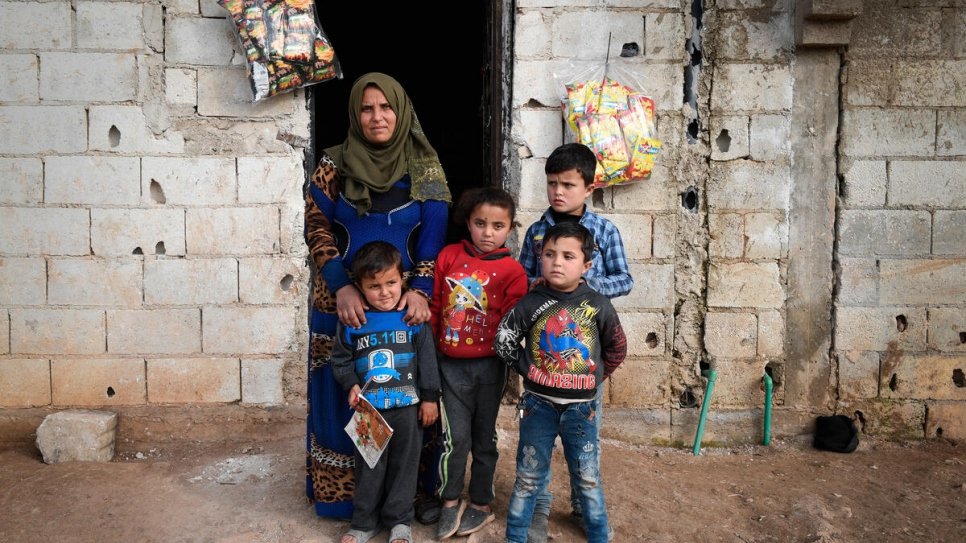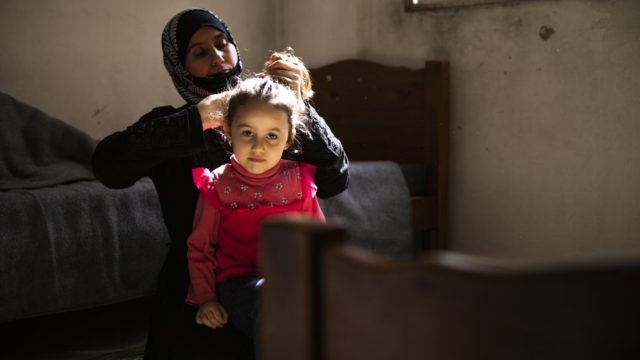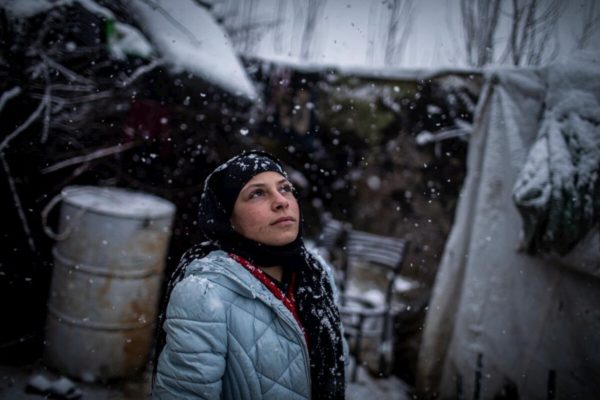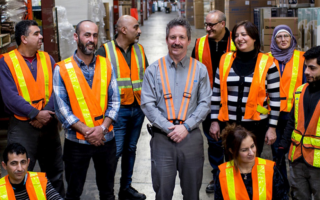
Abeer, 30, stands with her children outside their home in Dayr Hafir, Syria. © UNHCR/Bassam Diab
Compounding crises increase misery for Syrian families trying to pick up the pieces after ten years of conflict, including 6.7 million people still displaced inside the country.
By Bathoul Ahmed in Aleppo, Syria
In a dimly lit room of the tiny apartment in Aleppo where her family now lives, nine-year-old Amal sits on a mattress with a blanket covering a life-altering injury. Eight years ago, aged just 18 months, Amal lost her right leg when a shell struck their home in Hama city and exploded in the bedroom where she slept.
After fleeing the fighting, the family moved multiple times in search of safety before finally settling in Aleppo, Syria’s second city and former industrial hub that today still bears many of the scars of the country’s ten-year crisis.
“We moved from one house to another, from one area to another,” explained Amal’s mother Samar, 37. “The most difficult thing was being displaced time and time again, because every time we moved Amal, her wound would reopen again and bleed. It took seven months for it to heal.”
Following months of treatment, Amal is now able to walk to school with the help of a prosthetic leg, and dreams of one day becoming a lawyer. “I don’t like to sit idle,” Amal said. “I walk to school alone. I prefer it. It’s not hard. I made a bunch of friends at school, from the very first day.”
Against a backdrop of damaged buildings and piles of rubble in the impoverished neighbourhood where they live, signs of normal life are gradually returning along with the former residents who fled during the worst of the fighting.
But in spite of the tradesmen reclaiming damaged workshops and the return of rush hour traffic, beneath the surface the devastating impact of the past decade of turmoil can still be felt, and for many such as Amal’s family the hardship is worse than ever. Years of displacement have depleted any savings they had, leaving them unable to cover rent or medical expenses and relying entirely on aid agencies and handouts.
DONATE TO SUPPORT SYRIAN REFUGEES
“As much as I try to explain [to you] how difficult the situation is, it’s far worse,” Samar said. “Before the crisis we had our own home, my husband had a job. Now, before we buy anything, we have to think it over a hundred times before we buy it, be it food or clothes or anything else. I never imagined I would find myself in this state.”
Over the past decade, millions of Syrians like Amal and her family have been forced to flee their homes in what remains the world’s largest displacement crisis. Over 5.5 million Syrians are living as refugees in neighbouring countries, and 6.7 million are still displaced inside the country, including an estimated 2.5 million children.
Syria is also currently experiencing one of the worst socio-economic downturns since the start of the crisis. In the past year alone, the Syrian pound has lost three quarters of its value while the cost of food and other essential items has rocketed by more than 200 per cent. The onset of the COVID-19 pandemic has made an already dire situation worse.
The combined effect has been a dramatic reduction in purchasing power and rising levels of debt, leaving millions incapable of putting food on the table and meeting their basic needs. Today, over 13 million Syrians require humanitarian and protection assistance and almost 90 per cent of the population lives in poverty.
Yet despite the mammoth challenges, Syrians continue to find remarkable ways to persevere and try to rebuild their lives. Thousands of formerly displaced people are choosing to return to their towns and villages, often despite widespread destruction to homes, local schools, hospitals and other infrastructure.
“I faced many challenges trying to return home.”
Originally from Dayr Hafir, a city 50 kilometres east of Aleppo, 30-year-old mother-of-five Abeer and her family were displaced multiple times. Whilst in displacement, Abeer’s husband was killed on his way to buy food from a local market. A year later, following an improvement in the security situation in her city, Abeer chose to return.
“I faced many challenges trying to return home,” Abeer said. “I couldn’t afford to pay for anyone to bring us home, so we walked from dusk till dawn, bare foot and with no water. I lost my kids in the dead of night, but I was able to find them again.”
They arrived back to find their home damaged and looted. With no job or savings, Abeer had to start from scratch. For months they slept on the bare floor of the barren building, eating only the purslane she managed to grow in patches of land near their home. Abeer was forced to leave her young children alone each day while she went out in search of work.
“When we first got back, I faced some really difficult circumstances,” Abeer explained. “We went through periods where we didn’t even have cooking oil, or anything. I started working on the land and had to leave my kids home alone. I couldn’t afford to buy anything if I didn’t leave my kids alone to go and work.”
With an estimated 12.4 million Syrians currently food insecure, many families are forced to resort to harmful coping strategies including taking children out of school for work or forced marriages. Last year an estimated 2.5 million children in Syria were out of school, with a further 1.6 million at risk of dropping out.
With mounting debts, Abeer’s fortunes finally changed after she heard about a community centre in her area supported by UNHCR, the UN Refugee Agency, offering small business grants.
After successfully applying for the grant, Abeer was able to open her own mini market and now supports herself and her children with the income she generates.
“’The day I received [the grant], my brain couldn’t comprehend it. I thought I was in a dream,” Abeer said. “My life has gone from zero to a hundred. The most important thing is that I don’t need to leave my kids alone anymore.”
“I pray that my kids will have a beautiful life – better than mine.”
Abeer is also receiving support from a psychologist at the community centre to help cope with the loss of her husband and the many challenges she continues to face. Across Syria, years of displacement, exposure to violence, loss of loved ones, lack of jobs and deepening poverty continue to have a severe impact on people’s mental health.
Throughout the past ten years, UNHCR staff have been on the ground in Syria delivering critical assistance to families who have lost everything, including basic items like mattresses and blankets, provision of shelter kits and essential home repairs, psychosocial support and other protection services, and health care and education interventions such as equipment purchases and school rehabilitation.
While Syrian families like Abeer’s and Amal’s continue to show incredible resilience after a decade of struggle, the past year has pushed many to breaking point. Continued support from the international and humanitarian community is needed to help Syrians cope with worsening socio-economic conditions.
“I pray that my kids will have a beautiful life – better than mine,” Abeer said. “I want my kids to grow up and be successful, so they won’t need to rely on anyone. I don’t want them to be humiliated the way I have been.”





